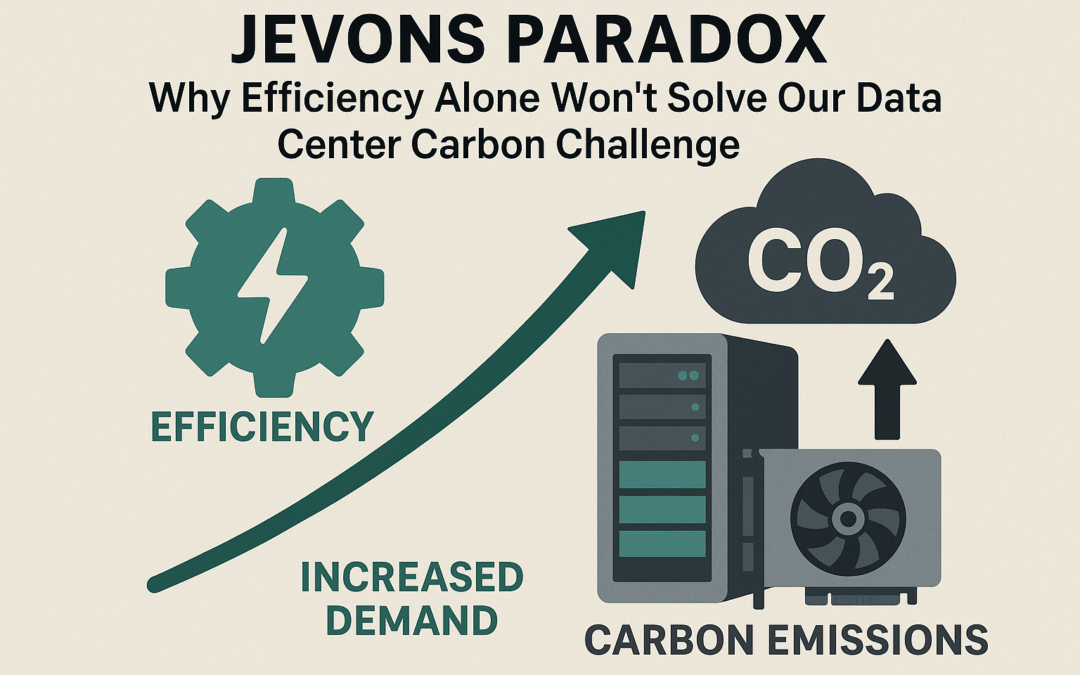What Is Jevons Paradox?
Jevons Paradox, first described by economist William Stanley Jevons in the 19th century, states that increasing the efficiency of using a resource often makes that resource cheaper and more accessible, which can lead to higher overall consumption rather than less. In the context of today’s digital infrastructure, this paradox is playing out in real time as breakthroughs in AI model efficiency—such as the much-discussed “DeepSeek moment” for GPUs—are making compute cheaper and more capable, but also driving explosive new demand for computational resources.
The Carbon Footprint Dilemma in Data Centers
- Efficiency gains in CPUs, GPUs, and cooling systems lower the cost and energy per computation.
- Lower costs and more accessible compute enable new applications, larger AI models, and wider adoption across industries.
- Demand for compute grows faster than efficiency gains, leading to higher total energy use and, ultimately, increased carbon emissions—even as each individual operation becomes “greener”.
This is the rebound effect in action: efficiency improvements alone do not guarantee a lower overall carbon footprint.
Why Efficiency Isn’t Enough
While efficiency is essential, it’s not a silver bullet. The data center industry has seen periods where energy use remained flat despite data growth, but since 2020, forecasts predict significant increases in data center electricity consumption through 2030, driven by AI and digitalization. The rebound effect means that without additional controls, efficiency gains can be overwhelmed by surging demand.
A Holistic Approach to Managing the Rebound Effect
To achieve net-zero compute, sustainability leaders must look beyond efficiency and address the systemic drivers of demand:
1. Smart Policy Interventions
- Carbon pricing and taxes: Internalizing the true cost of carbon emissions can align economic incentives with sustainability goals.
- Energy caps and regulatory limits: Setting absolute limits on energy use or emissions can prevent unchecked growth.
- Incentives for conservation: Rewarding verifiable reductions in energy use and emissions encourages continuous improvement.
2. Proactive Internal Strategies
- Track total energy consumption (not just PUE): Monitor kWh/year and carbon emissions, not just efficiency ratios.
- Optimize workload placement: Use renewable energy procurement and dynamic workload shifting to reduce carbon intensity.
- Implement internal carbon pricing: Make the environmental cost of compute visible to all business units, driving more responsible usage.
3. Behavioral and Architectural Shifts
- Encourage code and workload optimization: Promote efficient software development to reduce unnecessary compute cycles.
- Adopt serverless and modular architectures: Scale resources dynamically to avoid idle capacity and wasted energy.
- Invest in advanced cooling: Liquid cooling and heat reuse can further reduce the energy required for dense compute environments.
Key Takeaway for Sustainability Leaders
Efficiency gains are necessary but not sufficient. The Jevons Paradox and the rebound effect mean that without holistic management—including policy, operational, and behavioral changes—total resource consumption and carbon emissions can continue to rise even as each compute operation gets more efficient. The goal must be not just “more efficient compute,” but “net-zero compute.”
|
Solution Area |
Example Actions |
Why It Matters |
|
Policy Interventions |
Carbon taxes, energy caps, incentives |
Directly limits or prices emissions |
|
Internal Strategies |
Track kWh/year, optimize workloads, internal carbon price |
Makes true cost visible, drives cuts |
|
Behavioral/Architectural |
Code optimization, serverless, liquid cooling |
Reduces waste, matches demand to supply |
Summary Table: Addressing the Rebound Effect in Data Centers
By actively managing both efficiency and demand, the data center industry can move from incremental improvements to true sustainability.
About the Author
Wei Wang is a computer architect with ByteDance (San Jose). He has over 20 years of technology leadership experience shaping cutting-edge CPU architectures and microarchitectures that bridge real-world workloads and future-facing technology. Any views and opinions presented in this blog post belong solely to the author and do not represent those of the employer of the author.
Disclaimer: These posts are written by individual contributors to share their thoughts on the Computer Architecture Today blog for the benefit of the community. Any views or opinions represented in this blog are personal, belong solely to the blog author and do not represent those of ACM SIGARCH or its parent organization, ACM.


